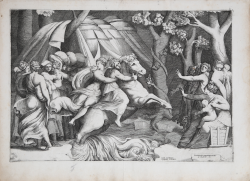





| Reference: | S48413 |
| Author | Giulio BONASONE |
| Year: | 1540 ca. |
| Measures: | 435 x 300 mm |




| Reference: | S48413 |
| Author | Giulio BONASONE |
| Year: | 1540 ca. |
| Measures: | 435 x 300 mm |
Engraving about 1540-46, signed in the plate at lower right. After a subject by Polidoro da Caravaggio.
Example in the second state of two, with the address of Antonio Lafreri.
Magnificent example, rich in shades, printed on contemporary laid paper with “pilgrim in the circle” watermark (Woodward nos. 3-6), with wide margins, very good condition.
This engraving records a fresco on a house at the Chiavica di Santa Lucia which Vasari mentions in his life of Polidoro, 'sul canto alla chiavica per andare a Corte Savella'. He lists a facciata with Cloelia crossing the Tiber, and a scene of sacrifice.
Cloelia was one of the ten daughters, who, with ten sons, of patrician Roman families, were given as hostages to Lars Porsena, the Etruscan king of Clusium, as a token of good faith following the conclusion of a treaty between Rome and the Etruscans. Cloelia escaped to Rome by re-crossing the Tiber on horseback, persuading her female companions to swim after her. The girls were sent back by the Romans but Porsena, in admiration of Cloelia's courage, presented her with a horse and restored her freedom together with that of her companions. Her escape across the Tiber was remembered in Republican and Imperial times as an example of female virtue, and there was a statue to her memory in the Via Sacra mentioned by Pliny and Dionysos of Halicarnassos.
Bonasone's inscription, with the word "imitando" may imply that the image was created in the spirit of Polidoro's original rather than strictly copying it. Perhaps the original was already lost when he engraved it. According to Vasari, the original composition appeared on the frieze of a building as a relief sculpture by Polidoro da Caravaggio, made around 1525-1526. The engraving was realized possibly around 1540-1546.
On the same subject, Polidoro realized another fresco, for the vault of the Salon in Villa Lante, today at Palazzo Zuccari, in Rome. After this fresco was derived another engraving. De Wit mistakenly ascribed to Giulio Bonasone, after Rosso Fiorentino, while it is recognized as work of Pierre Milan and René Boyvin.
Bibliografia
Bartsch, XV.134.83; Le Blanc, I.447.343; Massari, Iulio Bonasone, p. 67 n. 73; Witcombe, p. 112.
Giulio BONASONE (Bologna circa 1500 - Roma circa 1580)
|
Giulio Bonasone was born in Bologna in 1510; he was engraver, etcher and, as a painter, he was a pupil of Lorenzo Sabbatici.
The critics have ascribed to him 400 prints; nearly all of them are kept nowadays in the Institute of Graphic Design in Rome, widening the list of Bartsch, who had identified just 354 subjects. Bonasone started working in 1531 as copperplate engraver, as it can be seen from his S. Cecilia, and he was considered a follower of Marcantonio’s style in the last years. But Bonasone showed his own style quite soon, for Parmigianino asked him to engrave many of his works.
He lived in Rome between 1544 and 1547, working for the most important publishers of the time (Salamanca, Barlacchi, Lafrery), engraving subjects from Michelangelo, Raphael, Giulio Romano, Perin del Vaga and Polidoro da Caravaggio with his peculiar style.
|
Giulio BONASONE (Bologna circa 1500 - Roma circa 1580)
|
Giulio Bonasone was born in Bologna in 1510; he was engraver, etcher and, as a painter, he was a pupil of Lorenzo Sabbatici.
The critics have ascribed to him 400 prints; nearly all of them are kept nowadays in the Institute of Graphic Design in Rome, widening the list of Bartsch, who had identified just 354 subjects. Bonasone started working in 1531 as copperplate engraver, as it can be seen from his S. Cecilia, and he was considered a follower of Marcantonio’s style in the last years. But Bonasone showed his own style quite soon, for Parmigianino asked him to engrave many of his works.
He lived in Rome between 1544 and 1547, working for the most important publishers of the time (Salamanca, Barlacchi, Lafrery), engraving subjects from Michelangelo, Raphael, Giulio Romano, Perin del Vaga and Polidoro da Caravaggio with his peculiar style.
|